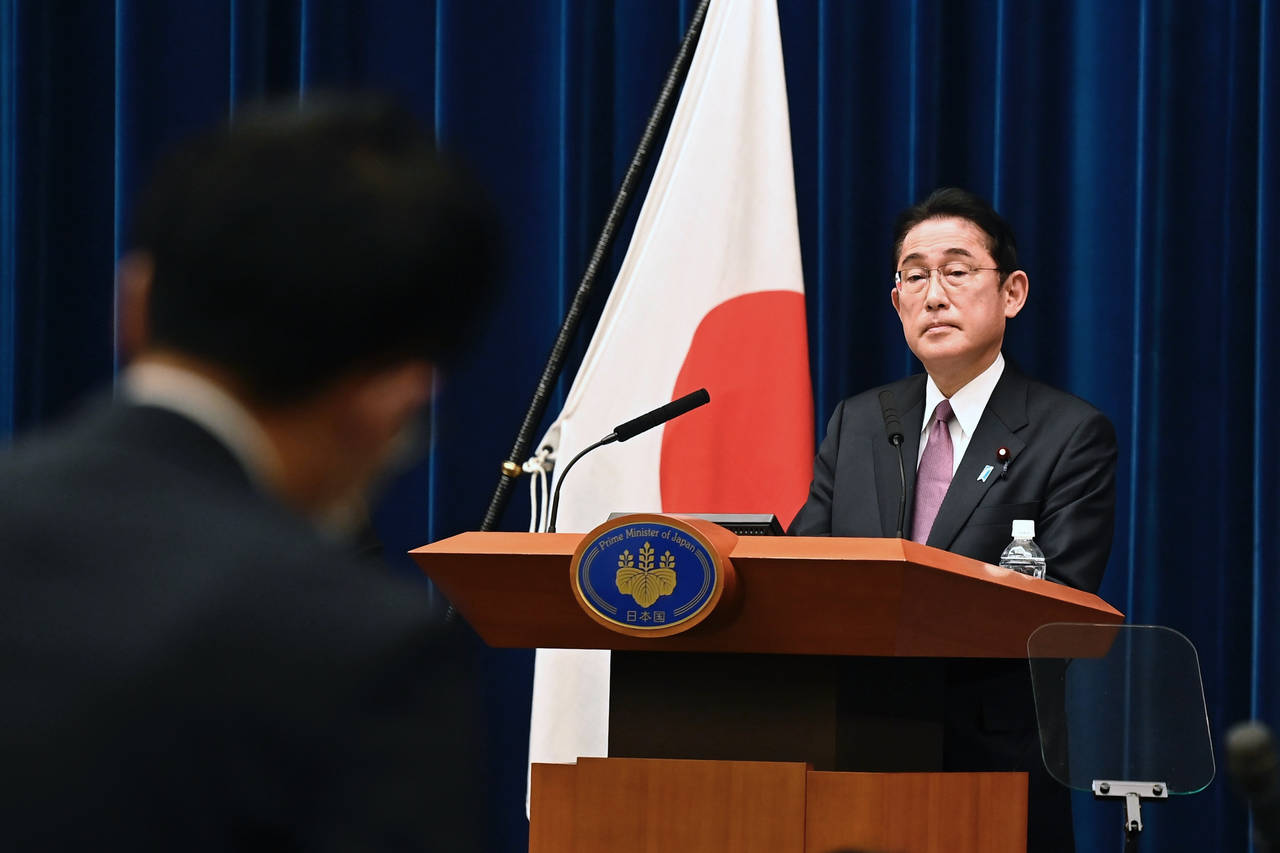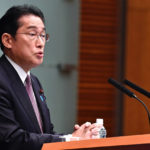As regional threats rise, Japan eases defense-only strategy
Dec 16, 2022, 1:21 AM | Updated: 7:34 am

Japan's Prime Minister Fumio Kishida attends a press conference at the prime minister's official residence in Tokyo, Friday, Dec. 16, 2022. In a major break from its strictly self-defense-only postwar principle, Japan adopted a national security strategy Friday declaring plans to possess preemptive strike capability and cruise missiles within years to give itself more offensive footing against threats from neighboring China and North Korea. (David Mareuil/Pool Photo via AP)
(David Mareuil/Pool Photo via AP)
TOKYO (AP) — In a major break from its strictly self-defense-only postwar principle, Japan adopted a national security strategy Friday declaring plans to possess preemptive strike capability and cruise missiles within years to give itself more offensive footing against threats from neighboring China and North Korea.
With China, North Korea and Russia directly to its west and north, Japan “faces the severest and most complicated national security environment since the end of the war,” the strategy said, referring to World War II. It named China as “the biggest strategic challenge” — before North Korea and Russia — to Japan’s effort toward ensuring the peace, safety and stability for itself and the international society.
Possession of the strike-back capability is “indispensable” as deterrence to discourage enemy attacks, Prime Minister Fumio Kishida told a news conference Friday, calling it “a major change to Japan’s postwar security policy.”
“When threats become reality, can the Self-Defense Force fully protect our country? Frankly speaking, the current (SDF capability) is insufficient,” Kishida said.
Under the strategy, Japan’s defense spending through 2027 will increase to about 2% of Japan’s GDP to total some 43 trillion yen ($320 billion), 1.6-times that of the current five-year total.
Kishida said the new target sets the NATO standard for defense spending, a budget increase that has been his policy priority since taking office in October 2021.
Because of its wartime past as an aggressor and national devastation after its defeat, Japan’s postwar policy prioritized the economic growth while keeping its security light by relying on American troops stationed in Japan under their bilateral security agreement. Japan’s defense buildup has long been considered a sensitive issue at home and in the region, especially for Asian victims of Japanese wartime atrocities.
But experts say China’s growing influence, Russia’s invasion of Ukraine and fear of Taiwan emergency prompted many Japanese to support increased capability and spending.
“Taiwan emergency and Japan emergency are inseparable,” said Ken Jimbo, a defense expert at Keio University, noting that Japan’s westernmost island of Yonaguni is only 110 kilometers (70 miles) away from Taiwan.
Rapid advancement of missiles have become “realistic threats” in the region, making interception by existing missile defense systems more difficult, the strategy said. North Korea fired more than 30 ballistic missiles this year, including one that flew over Japan. China fired five ballistic missiles into waters near Japanese southern islands including Okinawa.
Chinese Foreign Ministry spokesperson Wang Wenbin reiterated accusations Japan was “ignoring facts, deviating from its commitment to China-Japan relations and the common understandings between the two countries, and groundlessly discrediting China.”
“Hyping up the so-called China threat to find an excuse for its military build-up is doomed to fail,” Wang said Friday at a daily news briefing.
South Korea said Friday that Japan must consult with Seoul to receive consent before taking any action that gravely affects Seoul’s national interests, such as an exercise of its rights to counterstrike capability targeting the Korean Peninsula.
The South Korean Foreign Ministry said in a statement that it’s “desirable” for Japan to implement the security policy to contribute to regional peace and stability.
Counterstrike capability noted in Japan’s new strategy — approved alongside two defense strategy documents by Kishida’s Cabinet — won’t be implemented until at least 2026 when deployment of the powerful long-range Tomahawk missile, favored by the U.S. and U.K. navies, begins.
This puts an end to Japan’s 1956 government policy that shelved counterstrike capability and only recognized the idea as a constitutional last-ditch defense.
“Starting from the fundamental strengthening of the defense power, we must be firmly prepared for the worst case scenario,” the new strategy said.
Japan plans to spend 5 trillion yen ($37 billion) to deploy foreign-developed standoff missiles as early as 2026, including Lockheed Martin’s Tomahawk and Joint Air-to-Surface Standoff Missile, while Japan’s Mitsubishi Heavy Industry develops a surface-to-ship guided missile. To quickly respond to possible attacks, Japan will also deploy several standoff missile units at undisclosed locations.
Japanese defense officials said they are still negotiating Tomahawk purchase details.
After elevating its defense cooperation with Australia to semi-ally levels in recent years, Japan hopes to practice the new capability in joint exercises hosted by Australia and including U.S. militaries as well.
U.S. National Security Advisor Jake Sullivan in a statement said Japan’s new strategy “sets forth the vision of Prime Minister Kishida and the Japanese people for a broad and strong community of partners and allies in the region.”
“Japan’s goal to significantly increase defense investments will also strengthen and modernize the U.S.-Japan alliance,” he added.
Japan says its exclusive self-defense policy is unchanged, but “long-range cruise missiles represent a threshold capability that will fundamentally change Japan’s approach to deterrence,” said Christopher Johnstone, a senior advisor and Japan chair at the Center for Strategic and International Studies, said.
“An effective Japanese counterstrike capability would set the stage for a far deeper level of command-and-control integration with the United States than exists today,” he added.
Japan says it will keep its pacifist principle of high standards for arms equipment and technology transfer. But some easing is planned to allow currently restricted exports of offensive equipment and components, including those of next-generation fighter jet Japan is jointly developing with the U.K. and Italy, as a way to strengthen the country’s defense equipment industry.
Japan’s government has renamed what is known as preemptive strike to “counterstrike capability,” apparently to emphasize that it’s for self-defense. Despite a nuanced wording of the strategy, the main threat is China, for which Japan has had to prepare “by using North Korea’s threat as a cover” said Tomohisa Takei, a retired admiral of Japan’s navy.
The government says its use is constitutional if in response to signs of an imminent enemy attack. But it is extremely difficult to do and Japan needs to advance its cybersecurity and fully rely on the U.S. intelligence to be able to detect early signs of an enemy missile launch preparation, experts say, in order to effectively abort the attack without risking blame for making a first strike. It will require a deeper Japan-U.S. alliance to develop the capability, Johnstone said.
Experts, including former Defense Minister Shigeru Ishiba, said the definition of the enemy’s intention to attack is unclear and preemptive strikes could be considered as first strikes.
Last month, Japan and the United States held a major joint military exercise in southern Japan to step up the allies’ readiness.
___
Associated Press writers Hyung-jin Kim in Seoul, South Korea, and Ken Guggenheim in Washington contributed to this report.
Copyright © The Associated Press. All rights reserved. This material may not be published, broadcast, rewritten or redistributed.















